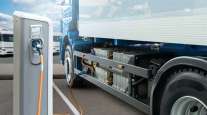Millions Spent to Clean Up California’s Diesel Trucks, but Is It Enough?

Older diesel trucks are some of the dirtiest polluters in California’s southern Central Valley.
So when the San Joaquin Valley Air Pollution Control District gets a few million dollars from the federal government or the California Energy Commission to replace some of those vehicles with newer, cleaner-burning models, or retrofit them with newer technology, the move is celebrated as a positive step to help clear up the valley’s chronic air pollution.
But how much does it help?
This spring, the U.S. Environmental Protection Agency awarded nearly $6.4 million to the air district to replace older diesel trucks for those that run nearly 90% cleaner, and older farm tractors for those that meet the latest emissions standards.
RELATED: Trump eyes twice-failed legal strategy to fight California regulations
That chunk of change ultimately will affect 144 trucks and 237 agricultural tractors, air officials say. That’s a lot of harmful nitrogen oxide and soot particles that won’t be getting into the air.
But what percentage of the huge number of trucks that crisscross the valley every day, seven days a week, will be affected by the program?
“We greatly appreciate EPA’s attention and care for the health of valley residents,” Seyed Sadredin, the district’s executive director and pollution control officer, said in a written statement. “This grant from EPA will help us with our enormous challenge to reduce emissions from mobile sources, which make up 85% of the pollution in the San Joaquin Valley.”
Despite that sunny outlook, Sadredin and the man who will replace him July 6, Samir Sheikh, know that the 1,770 trucks replaced by the district in recent years through its Truck Replacement Program is less than 1% of the estimated 226,000 trucks operating in the valley on any given day.
The district needs about $1 billion a year to replace hundreds of thousands of trucks, Sadredin says. But that level of funding is not available to the valley.
Some argue that the region, with its chronic air pollution, deserves emergency funding to combat the problem. Shouldn’t the areas suffering the most receive the most help from Congress and EPA?
“We 100% believe that the San Joaquin Valley should be a top priority when allocating these funds, and we have worked very hard to ensure that the valley receives its fair share of both state and federal funding,” said Jaime Holt, the district’s chief communications officer.
RELATED: SoCal regulators see chance to rein in freight pollution
The district often receives half of the available funding for EPA Region 9, which includes Western states and territories, Holt said, even though the population in the valley is relatively small when compared with areas such as the South Coast district and the Bay Area.
“Longhaul trucks are getting pretty clean,” said Tom Frantz, a Shafter-area almond grower who has advocated for cleaner valley air for decades. “The trucks used for seasonal harvests are filthy, so help is needed to replace them.
“I truly believe electric trucks will soon be available for local uses, and that’s where the money should go. We should start with electrifying the thousands of milk and feed trucks used daily by the dairy industry.”
Frantz cited a 2008 study by Jane V. Hall, an environmental economist at Cal State Fullerton who calculated the cost of air pollution in the San Joaquin Valley at more than $1,600 per person per year, or $6 billion to the region’s economy. Meeting federal clean-air standards would redirect that money to more productive ends, Hall said.
Exposure to air pollution causes premature death, hospitalizations and respiratory symptoms, limiting a person’s normal daily activity and increasing school absences and loss of workdays, the researchers said.
Fortunately, EPA isn’t the air district’s only funding source for programs designed to clean up pollution from fuel combustion, including heavy-duty diesel truck exhaust, tractors and school buses.
In April, the valley air district governing board accepted $8 million in funding from the California Energy Commission to replace older, high-polluting trucks in the valley. The grant will provide funding to replace an additional 80 trucks.
RELATED: California ports tout progress in fight against environmental pollution
“Through the CEC award and other new funding,” Sheikh said in an e-mail, “the district has been successful this past year in bringing new funding resources to the valley and encourages businesses to participate in the district’s grant programs and take advantage of funding before it runs out.”
But everyone, including the incoming director, seems to agree that more and consistent funding is needed to tackle this environmental health crisis.
“While this funding is helpful for the valley, achieving the magnitude of emissions reductions required for attainment in an expedited manner will only be feasible through significantly greater and sustained funding commitments from the state and federal governments for the deployment of new clean mobile source technologies,” Sheikh said.
Even Frantz says these programs are a step in the right direction. But if we are really serious about cleaning the air, the “M” in millions will need to be replaced by the “B” in billions.
“At this rate of progress,” he said, “we’ll get there in 2070.”
Distributed by Tribune Content Agency, LLC




